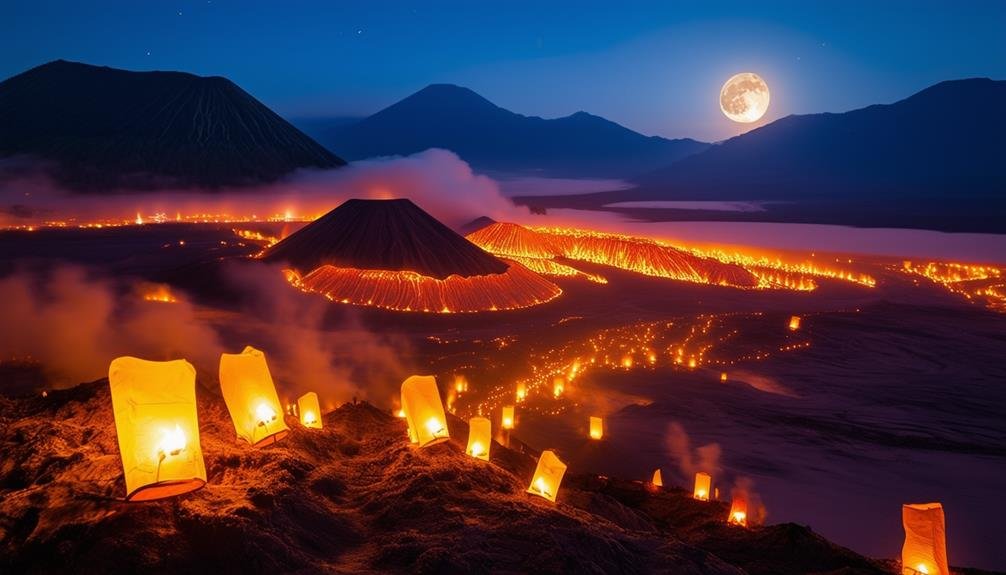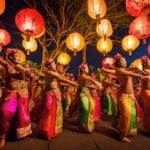The Yadnya Kasada is a centuries-old festival that takes place on the majestic slopes of Mount Bromo. This sacred celebration honors the sacrifices of a brave princess and showcases the Tengger people‘s deep respect for nature and their ancestors. With roots in Hinduism and Buddhism, this festival is a testament to the rich cultural heritage of Indonesia.
As you learn more about this fascinating tradition, you’ll uncover the significance behind the offerings thrown into the volcano, and the true essence of this ancient ritual will slowly start to unfold.
Key Takeaways
• Yadnya Kasada is a significant festival in Indonesia, celebrated annually on July 14th-15th, showcasing the Tengger people’s cultural heritage.
• The festival is connected to Mount Bromo, where participants throw offerings into the volcano as a symbol of gratitude and respect for nature.
• Rooted in Hinduism and Buddhism, Yadnya Kasada reflects the Tengger people’s cultural significance and their respect for nature and ancestors.
• The festival is an integral part of the Tengger people’s lives, strengthening their bond with nature and ancestors, and ensuring a prosperous harvest and protection.
• Yadnya Kasada is a unique cultural experience, offering a glimpse into Indonesia’s rich cultural diversity and heritage.
What is Yadnya Kasada and Why and When Yadnya Kasada is celeberated

As you explore the world of Yadnya Kasada, you’ll uncover a rich fabric of cultural significance and local legends. This sacred ritual is a testament to the deep connection between the Tengger people and the mighty Mount Bromo, a volcanic wonder in East Java.
According to local legends, Yadnya Kasada commemorates the sacrifice of a princess to appease the volcano’s wrath, ensuring the community’s safety and prosperity.
Facts AboutYadnya Kasada
As you explore the core of Yadnya Kasada, you’ll uncover a fascinating array of facts that intertwine to create the rich fabric of this ancient ritual. You’ll discover that Yadnya Kasada is deeply rooted in Hinduism and Buddhism, reflecting the cultural significance of the Tengger people.
This ritual is a testament to the ancient traditions that have been passed down through generations, showcasing the community’s resilience and dedication to their heritage.
| Aspect | Description | Importance |
|---|---|---|
| Ritual Practices | Yadnya Kasada involves a series of rituals, including the throwing of offerings into the crater of Mount Bromo. | Reflects the community’s connection with nature and their ancestral heritage. |
| Cultural Significance | The ritual is a symbol of gratitude and respect for the gods and the land. | Demonstrates the community’s deep respect for their cultural traditions. |
| Ancient Traditions The ritual has been practised for centuries, with origins dating back to the 15th century. | Highlights the community’s commitment to preserving their ancient traditions.
Why Yadnya Kasada Is Celeberated
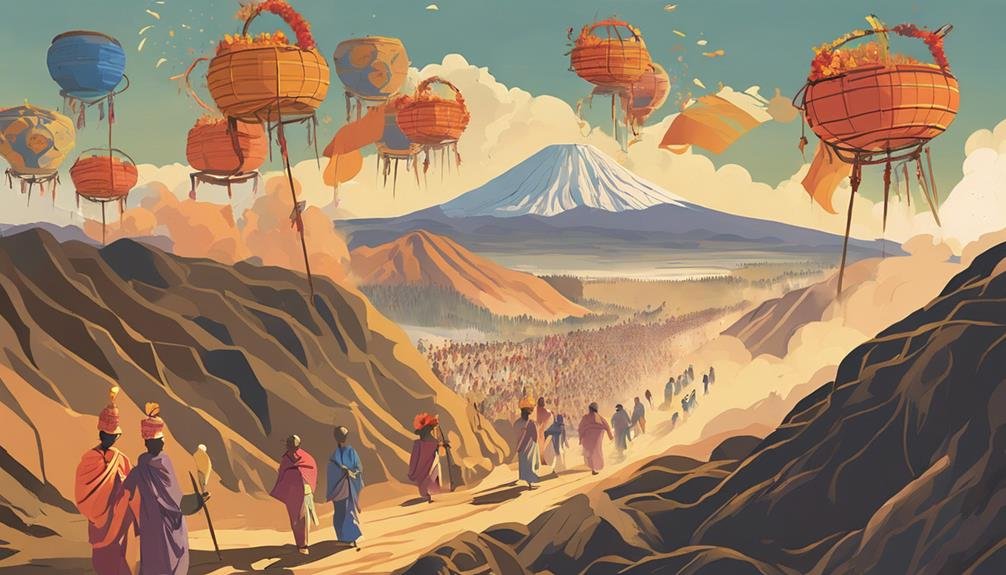
You’re about to uncover the significance behind celebrating Yadnya Kasada, a ritual that has been an integral part of the Tengger people‘s lives for centuries. As you explore the world of Yadnya Kasada, you’ll discover that it’s not just a ritual, but a celebration that holds immense cultural significance. The Tengger people, residing in the Bromo Tengger Semeru National Park, have been observing this ritual for generations, and it’s an integral part of their identity.
You might wonder, why is Yadnya Kasada celebrated with such fervor? The answer lies in its ritual importance. The festival is a confirmation of the community’s deep-rooted connection with nature and their ancestors. The Tengger people believe that Yadnya Kasada strengthens their bond with the divine, ensuring a prosperous harvest and protection from natural disasters. By participating in the ritual, they’re not only honoring their heritage but also reaffirming their commitment to their cultural traditions. As you explore the world of Yadnya Kasada, you’ll come to realize that it’s more than just a celebration – it’s a way of life.
Etymology of Yadnya KasadaIndonesia
During the 15th century, the term ‘Yadnya Kasada‘ emerged in the Tengger community, derived from the Sanskrit words ‘yajna,’ meaning ‘ritual’ or ‘sacrifice,’ and ‘kasada,’ referring to the twelfth month of the Tengger calendar.
As you explore the world of Yadnya Kasada, you’ll discover that this term holds significant cultural significance. The ritual practices associated with Yadnya Kasada are deeply rooted in the Tengger community’s spiritual beliefs and traditions.
For the Tengger people, Yadnya Kasada is more than just a celebration; it’s an opportunity to connect with their ancestors and the divine. The term’s etymology is a reflection of the community’s rich cultural heritage, showcasing their deep understanding of the sacred and the profane.
As you investigate the world of Yadnya Kasada, you’ll come to appreciate the intricate web of meanings and associations that underlie this sacred ritual.
History of Yadnya KasadaIndonesia
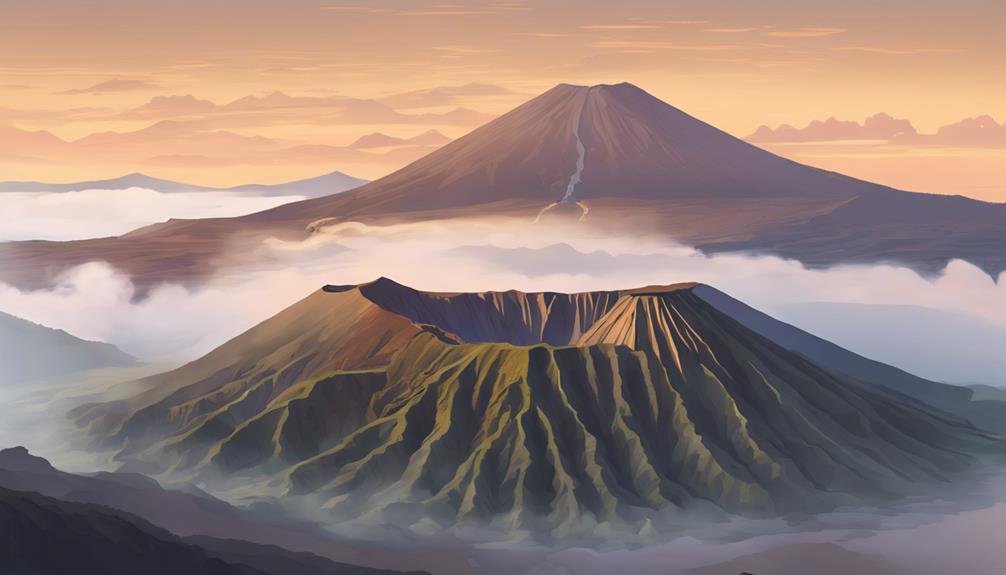
As you explore the history of Yadnya Kasada Indonesia, you’ll find that it’s rooted in ancient Hindu traditions that were brought to the island of Java centuries ago.
You’ll discover that the Tenggerese tribe, indigenous to the region, has played a significant role in shaping the festival’s unique character.
Meanwhile, the involvement of Brahmin priests has added another layer of complexity to this rich cultural heritage.
Ancient Hindu Roots
In the misty valleys of ancient Java, the seeds of Yadnya Kasada were sown, nourished by the rich cultural heritage of Hinduism that had taken root in Indonesia centuries prior. As you explore the history of Yadnya Kasada, you’ll discover that Hindu mythology played a significant role in shaping the festival’s traditions and practices. The ancient Hindus brought with them their rich cultural heritage, which merged with the existing traditions of the Indonesian archipelago. This blending of cultures resulted in a unique cultural identity that’s still celebrated today.
Cultural preservation was an essential aspect of Hinduism’s influence on Yadnya Kasada. The festival’s rituals and ceremonies were carefully passed down through generations, ensuring that the cultural heritage of Hinduism remained vibrant and alive. You can still see this cultural preservation in action today, as the Tenggerese people continue to honor their Hindu ancestors through their participation in Yadnya Kasada. As you explore the history of Yadnya Kasada, you’ll begin to appreciate the intricate fabric of Hindu mythology and cultural preservation that has been woven into the fabric of Indonesian culture.
Tenggerese Tribal Traditions
You’ll find that the Tenggerese people’s strong tribal traditions have been instrumental in preserving the cultural heritage of Hinduism, which has been woven into the fabric of Yadnya Kasada. As you explore further into the history of this sacred festival, you’ll notice that the Tenggerese rituals are an intricate blend of ancient Hindu practices and indigenous customs. These rituals, passed down through generations, have been shaped by the tribe’s unique cultural identity and its connection to the mystical Mount Bromo.
In the domain of tribal anthropology, the Tenggerese people’s traditions offer a fascinating case study. Their rituals, infused with a deep sense of spirituality, are a confirmation to the tribe’s resilience and adaptability. You’ll observe that the Tenggerese people’s strong sense of community and shared cultural heritage has enabled them to preserve their traditions, even in the face of external influences. As you explore the Tenggerese tribal traditions, you’ll gain a deeper understanding of the intricate cultural network that underlies the Yadnya Kasada festival.
Brahmin Priest Involvement
The participation of Brahmin priests in Yadnya Kasada’s history dates back to the 15th century when they arrived on Java’s eastern flank, bringing with them a wealth of Hindu knowledge and customs that would eventually intertwine with the Tenggerese people‘s indigenous traditions. As you explore further into the history of Yadnya Kasada, you’ll discover that Brahmin priests played a pivotal role in shaping the festival’s rituals and practices. Their duties involved performing priestly rituals, such as conducting sacred ceremonies and reciting ancient Hindu scriptures. These rituals not only honored the gods but also aimed to bring prosperity and good fortune to the Tenggerese people.
The Brahmin priests’ involvement also led to the blending of Hindu and indigenous customs, resulting in a unique cultural heritage that’s distinct to the Tenggerese people. As you investigate the history of Yadnya Kasada, you’ll begin to appreciate the significant contributions of the Brahmin priests, whose dedication to their duties has helped preserve the festival’s rich cultural heritage.
What Are The Dates Yadnya KasadaIndonesia Takes Place
Your trip to Mount Bromo, Indonesia, coincides with the Yadnya Kasada festival, which takes place annually from July 14th to 15th, a timing that’s deeply rooted in the region’s cultural heritage. This festival is a significant event for the Tenggerese people, who have been celebrating it for centuries. As a visitor, you’ll have a unique opportunity to immerse yourself in the local culture and experience the rich traditions of the region.
| Date | Event | Description |
|---|---|---|
| July 14th | Festival Opening | Traditional attire is a must, as you’ll witness the vibrant costumes of the Tenggerese people. |
| July 14th-15th | Cultural Immersion | Engage with the locals and experience their warm hospitality. |
| July 15th | Main Ceremony | The highlight of the festival, where you’ll see the unique traditions and rituals of the Tenggerese people. |
| July 15th | Closing Ceremony | A grand finale to the festival, with fireworks and celebrations. |
During the festival, you’ll have the chance to don traditional attire, which is an integral part of the celebration. As you mingle with the locals, you’ll gain a deeper understanding of their cultural heritage and traditions.
Main Activities & Events in Yadnya KasadaIndonesia
As you explore the vibrant festival of Yadnya Kasada Indonesia, you’ll discover a plethora of activities and events that showcase the rich cultural heritage of the region. The festivities are a reflection of the community’s spirit and creativity, with various activities that cater to diverse interests.
To give you a glimpse into the excitement, here are some of the main activities and events you can expect:
- Traditional Dance Performances: Watch in awe as locals don traditional attire and perform intricate dances that have been passed down through generations.
- Food Festivals: Indulge in a culinary journey as the festival offers a wide range of traditional dishes, each with its own unique flavors and ingredients.
- Local Craft Exhibitions: Marvel at the skillful craftsmanship of local artisans as they showcase their handmade products, from textiles to woodcarvings.
- Cultural Processions: Join in the vibrant processions that wind through the streets, featuring colorful costumes, music, and laughter.
Related Festivals In The Same Region
While exploring the cultural landscape of East Java, you’ll discover that Yadnya Kasada is part of a rich array of festivals that celebrate the region’s unique heritage. As you investigate further, you’ll find that these festivals share a common thread – a deep respect for the land, the people, and the culture.
| Festival | Description | Location |
|---|---|---|
| Java Jazz Festival | A celebration of jazz music featuring local and international artists | Jakarta, Java |
| Baliem Valley Festival | A showcase of Papuan culture, featuring traditional music and dance | Wamena, Papua |
| Dieng Cultural Festival | A celebration of Javanese culture, featuring traditional music, dance, and theater | Dieng, Java |
These festivals, like Yadnya Kasada, are a reflection of the region’s rich cultural diversity. From the jazz rhythms of Jakarta to the traditional dances of Bali, each festival offers a unique glimpse into the region’s heritage. As you explore these festivals, you’ll gain a deeper appreciation for the region’s cultural panorama and the people who weave it.
Interesting Less Known Facts About Yadnya KasadaIndonesia
In the heart of East Java, Indonesia, you’ll discover a unique and fascinating festival, Yadnya Kasada, which has been shrouded in mystery for centuries, waiting to be unraveled. This ancient Hindu festival is a tribute to the rich cultural heritage of the Tengger people, who inhabit the slopes of Mount Bromo.
Some interesting facts about Yadnya Kasada include:
- Ancient Origins: Yadnya Kasada dates back to the 15th century, with roots tracing back to the Hindu Majapahit Kingdom.
- Volcanic Offerings: The festival involves throwing offerings of vegetables, fruits, and flowers into the volcano’s crater, symbolizing the Tengger people’s gratitude for the land’s fertility.
- Traditional Costumes: Participants wear traditional attire, including intricately woven fabrics and ornate headdresses, showcasing the region’s rich textile heritage.
- Agricultural Significance: Yadnya Kasada marks the beginning of the agricultural season, highlighting the importance of the land and the community’s dependence on it.
| Cultural Significance | Traditional Practices |
|---|---|
| Preserves Tengger identity | Involves traditional costumes |
| Honors the land’s fertility | Includes agricultural rituals |
| Reflects Hindu heritage | Features offerings to the volcano |
| Fosters community unity | Involves collective participation |
| Celebrates the land’s bounty | Marks the start of the harvest season |
Tips for attending the Yadnya KasadaIndonesia
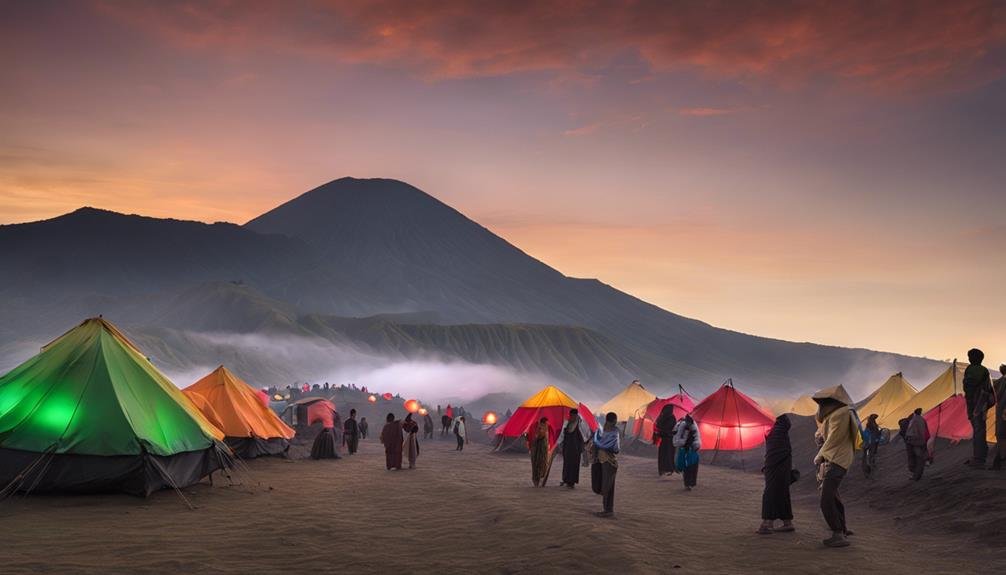
Before heading to Mount Bromo, you’ll want to prepare for the high altitude and unpredictable weather by packing layers, comfortable shoes, and a waterproof jacket. It’s essential to prioritize your physical comfort to fully immerse yourself in the Yadnya Kasada festival.
To enhance your experience, consider hiring a local guide who can provide valuable insights into the Tenggerese culture. This will enable you to appreciate the nuances of the festival and engage in meaningful interactions with the locals.
Opt for a guided tour that focuses on cultural immersion, allowing you to participate in traditional ceremonies and learn about the customs and traditions of the Tenggerese people. By doing so, you’ll not only gain a deeper understanding of the festival but also contribute to the local economy.
Remember to be respectful of the local customs and traditions, and always follow the guidance of your local guide. With an open mind and a willingness to learn, you’ll be able to truly appreciate the beauty of Yadnya Kasada.
History of Indonesia
As you explore the intricate fabric of Indonesia’s past, you’ll uncover a complex story woven from the threads of ancient empires, colonialism, and modern nation-building.
The archipelago’s strategic location has made it a prized possession for centuries, with various powers vying for control. The Dutch colonization of Indonesia, which lasted from the early 17th century to the mid-20th century, had a profound impact on the country’s development.
This period saw the exploitation of natural resources, the imposition of Western values, and the suppression of indigenous cultures. However, it also sparked a growing sense of Indonesian identity, as the colonized people began to resist their oppressors and forge a unified national consciousness.
The struggle for independence, led by figures like Sukarno and Hatta, ultimately resulted in Indonesia’s independence in 1945. Today, as you explore further into Indonesia’s history, you’ll discover a rich mosaic of cultures, traditions, and experiences that have shaped the nation into what it is today.
Location of Indonesia
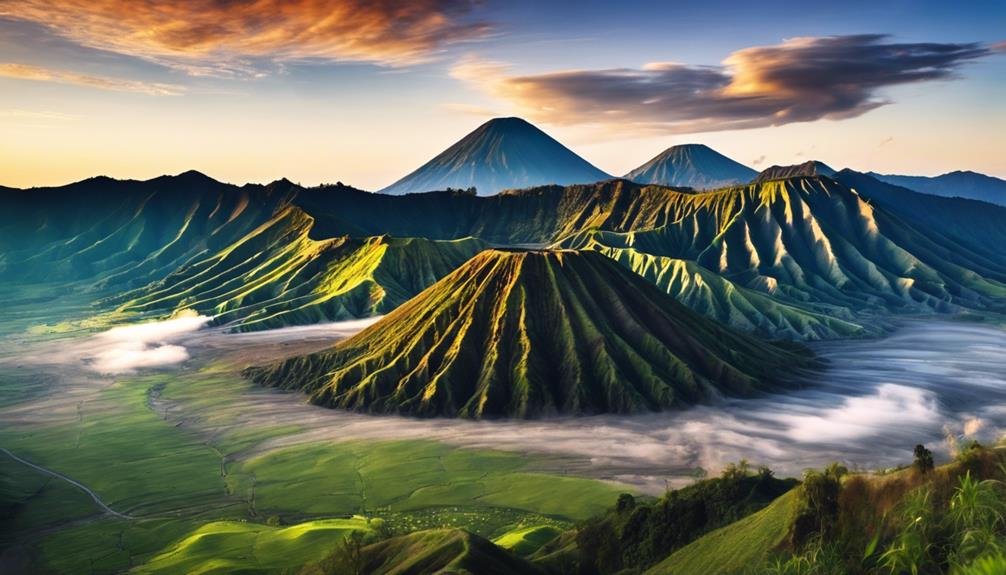
As you prepare to experience the rich cultural heritage of Yadnya Kasada in Indonesia, you’re probably wondering where exactly this beautiful country is located and how to get there.
You’ll want to know the nearest cities or towns to visit, as well as what to expect from the weather. Let’s explore the location of Indonesia and what it has in store for you.
Weather In Indonesia
Indonesia’s strategic location near the equator means you’re in for a tropical climate, with high temperatures and high humidity levels throughout the year. As you explore this beautiful country, you’ll experience a climate that’s warm and humid, with two distinct monsoon seasons: the wet monsoon from October to April, and the dry monsoon from May to September.
The tropical climate is characterized by high temperatures, ranging from 20°C to 30°C (68°F to 86°F), and humidity levels often reaching 60-80%. The climate varies across different regions, with the coastal areas being hotter and more humid than the mountainous regions.
Here’s a breakdown of the climate in different regions of Indonesia:
| Region | Temperature (°C) | Humidity (%) |
|---|---|---|
| Coastal areas | 25-30 | 60-80 |
| Mountainous regions | 15-20 | 50-60 |
| Islands (e.g., Bali, Lombok) | 20-25 | 60-70 |
| Rainforests (e.g., Sumatra, Kalimantan) | 20-25 | 70-80 |
As you plan your trip to Indonesia, be prepared for the tropical climate and monsoon seasons. Pack light, breathable clothing, and don’t forget your sunscreen and umbrella!
Famous Landmarks in Indonesia
As you wander through the archipelago, majestic structures and ancient ruins beckon, each one a tribute to the country’s rich cultural heritage. You’ll discover a plethora of breathtaking landmarks that showcase Indonesia’s architectural and historical prowess.
Some of the most iconic landmarks include:
- Borobudur Temple: A majestic Buddhist temple and UNESCO World Heritage Site, famous for its intricate carvings and majestic stupas.
- Prambanan Temple: A stunning Hindu temple complex, adorned with ornate carvings and towering structures.
- Monas National Monument: A towering monument in Jakarta, symbolizing Indonesia’s struggle for independence.
- Lake Toba: A majestic caldera lake, surrounded by picturesque villages and lush green landscapes.
As you explore these landmarks, you’ll gain a deeper appreciation for Indonesia’s rich cultural fabric and its ability to blend tradition with modernity.
Famous Historical Personalities from Indonesia
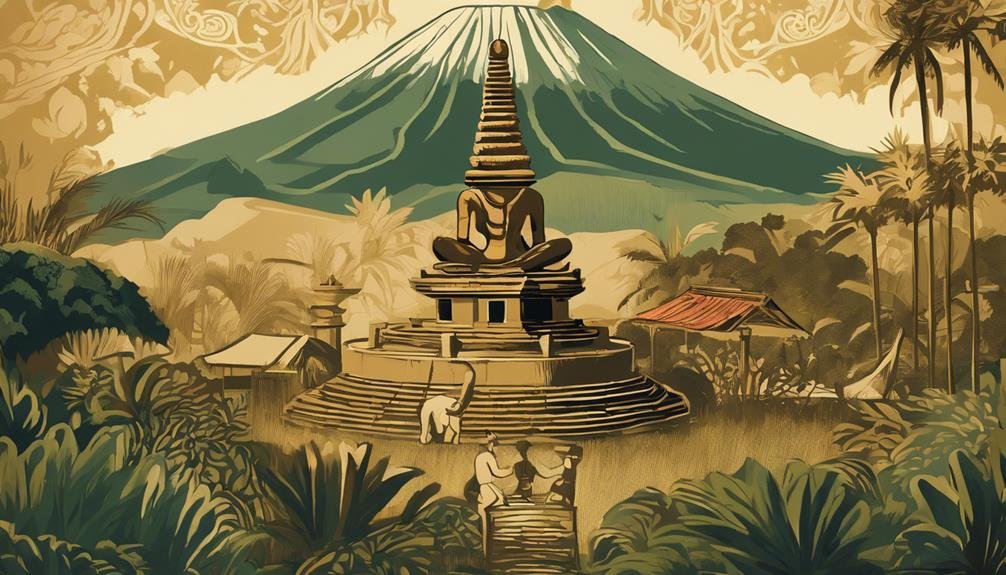
Among the many influential figures who shaped Indonesia’s history, few are as revered as the national heroes who fought for independence, pioneered social reforms, and inspired the nation. As you explore the country’s rich past, you’ll discover remarkable individuals who left an indelible mark on Indonesian society.
Some notable figures include:
- Sultan Agung was a powerful leader who united the Mataram Sultanate in the 17th century and played an essential role in shaping Indonesia’s cultural identity.
- Raden Saleh, a renowned painter and Indonesia’s first modern artist, who introduced European art styles to the country and paved the way for future generations of artists.
- Cut Nyak Dien, was a courageous female warrior who fought against the Dutch colonial powers and became a symbol of resistance and female empowerment.
- Soekarno, Indonesia’s first president, led the country to independence and became a beacon of hope for the nation.
These historical personalities haven’t only shaped Indonesia’s past but continue to inspire its people, fostering a sense of national pride and unity.
Famous Foods From Indonesia
While exploring Indonesia’s rich history, you’ve likely worked up an appetite, and fortunately, the country’s culinary landscape is just as invigorating, with popular dishes that have been perfected over generations. Indonesian cuisine is a reflection of the country’s cultural diversity, with influences from Chinese, Indian, and Middle Eastern traditions. As you wander through Indonesia’s bustling streets, you’ll discover a thriving street food culture that’s hard to resist.
Here are some must-try dishes that showcase the best of Indonesian cuisine:
- Nasi Goreng: a flavorful fried rice dish often served with a fried egg and chicken.
- Gado-Gado: an invigorating salad of mixed vegetables, tofu, and tempeh, topped with peanut sauce.
- Sate: grilled meat skewers, typically made with chicken, beef, or pork, and served with spicy peanut sauce.
- Martabak: a stuffed pancake with savory fillings like eggs, vegetables, and meat.
What is the significance of Galungan in Indonesia compared to Yadnya Kasada?
Galungan in Indonesia is a significant Hindu Balinese holiday, marking the victory of dharma over adharma. It is a time for family reunions, offering prayers, and making offerings to ancestors. On the other hand, Yadnya Kasada is a Tenggerese festival in Indonesia, celebrated by the Tenggerese people in Bromo.
Frequently Asked Questions
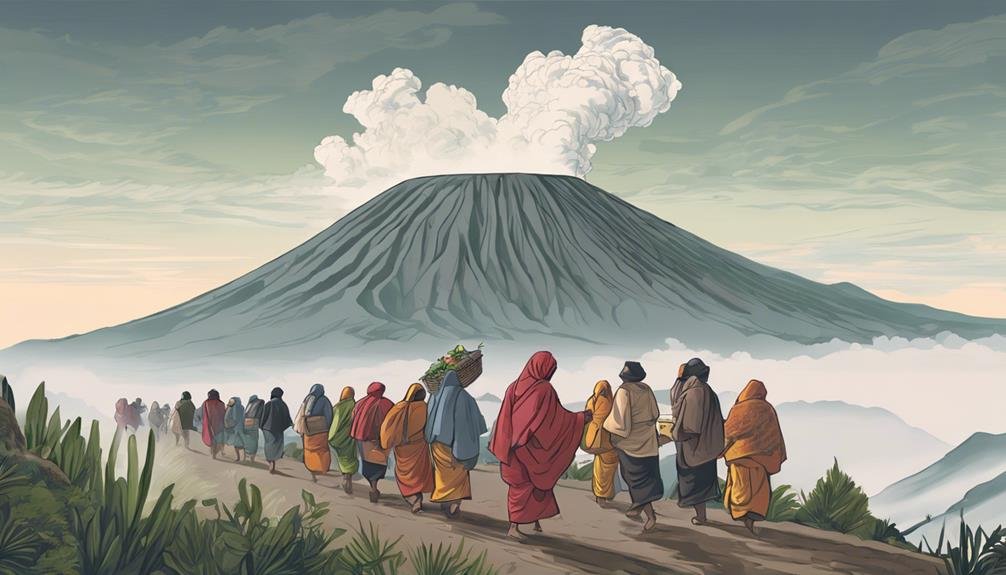
Having explored the vibrant world of Indonesian cuisine, you’re likely wondering about the cultural significance of certain dishes or ingredients, and that’s exactly what we’ll investigate in this FAQ section.
One common question is, ‘What’s the deal with spice levels in Indonesian food?’ The answer lies in the cultural significance of spices, which are often used to symbolize hospitality and warmth towards guests. You’ll notice that many dishes, like sambal, are intentionally spicy to showcase the host’s generosity and welcoming nature.
Another question on many minds is, ‘How do locals participate in Yadnya Kasada festivities?’ The answer is through local participation in traditional cooking, where villagers come together to prepare massive quantities of food for the festivities. This communal cooking process strengthens social bonds and reinforces the cultural significance of food in Indonesian communities.
Lastly, you might be wondering, ‘What’s the significance of rice in Indonesian cuisine?’ In Indonesia, rice is a staple that represents prosperity and good fortune. Its presence is a symbol of abundance and gratitude, which is deeply rooted in the country’s cultural heritage.
Frequently Asked Questions
Is Yadnya Kasada Only Celebrated in Indonesia?
You might think that Yadnya Kasada is exclusive to Indonesia, but it’s not; this ancient ritual, rooted in Hindu traditions, holds cultural significance beyond borders, reflecting the diverse spread of Hinduism.
Can Tourists Participate in the Yadnya Kasada Festival?
As you consider participating in cultural festivals, you’ll find that some events welcome tourists, while others remain closed to outsiders. When it comes to Yadnya Kasada, you can participate, but be respectful of local customs, embracing cultural immersion.
What Is the Significance of the Bromo Volcano in Yadnya Kasada?
As you explore the Bromo Volcano, you’ll discover its significance lies in the vibrant rituals and ancient mythology surrounding it, where locals believe the volcano’s majesty holds spiritual power, influencing the balance of nature and human life.
Are There Any Specific Dress Codes for Attending Yadnya Kasada?
As you prepare to attend a cultural event, you wonder about the dress code; traditionally, you’ll want to don cultural attire, such as intricately patterned traditional garments, to show respect and blend in with the local crowd.
Can I Take Pictures During the Yadnya Kasada Festival?
When attending cultural festivals, you’ll want to exercise camera etiquette, being mindful of cultural sensitivity. Refrain from taking pictures during sacred rituals, and always ask permission before snapping photos of locals, respecting their traditions and privacy.
Conclusion
As you explore Yadnya Kasada, you’re struck by the rich cultural heritage of Indonesia.
This ancient festival is more than just a tribute – it’s a proof of the country’s resilience and traditions.
With its fascinating history, vibrant landmarks, and delectable cuisine, Indonesia is a treasure trove of experiences waiting to be discovered.
